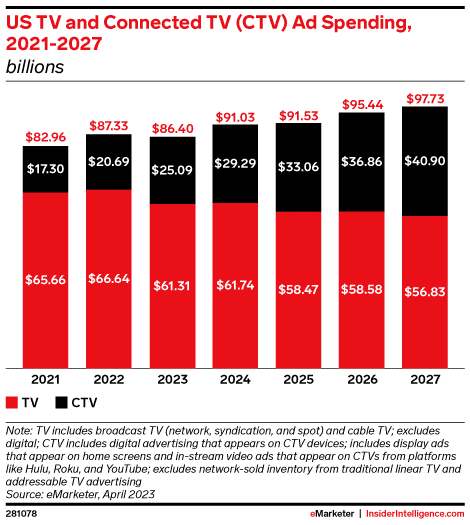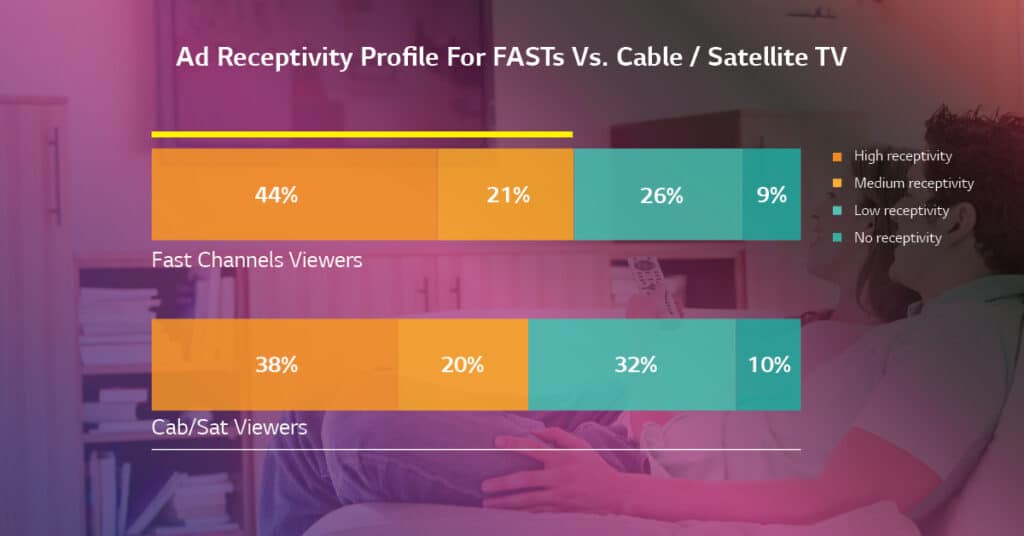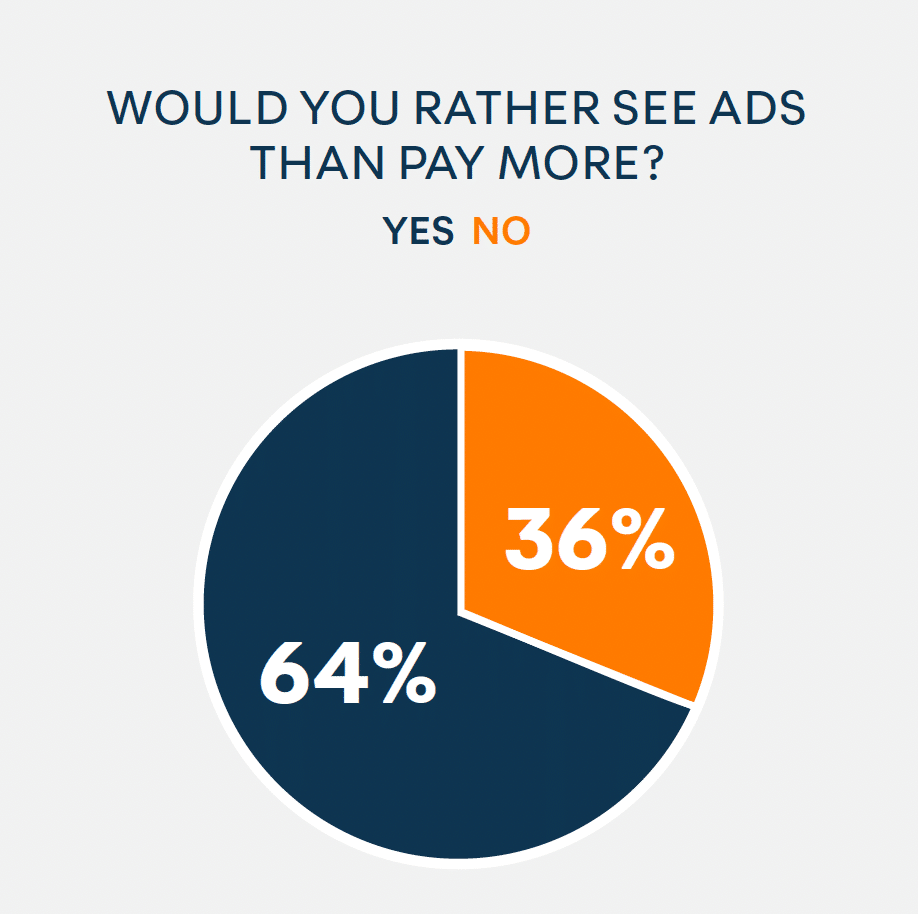When it comes to the efficiency of connected TV (CTV) advertising, the numbers speak for themselves. The problem is, there are a lot of numbers. To help you understand the channel’s magnitude, we’ve dug through hundreds of them and compiled 20 of the top CTV stats for 2023.
We’ve broken down the CTV stats by category: ad spend, proven performance, consumer demographics and behavior, and those specific to the pharma industry.
CTV Advertisers and Skyrocketing Spend
CTV had already been growing in popularity for years and the pandemic only accelerated that. With little to do and nowhere to go, millions of people spent months on the couch streaming their favorite shows. When marketing channels become more popular with consumers, advertisers are usually pretty close behind. As a result, there are probably more CTV stats related to ad spend than anything else. These five are particularly noteworthy.
- CTV ad spend grew a staggering 89% from 2020 to 2022. While 2023 estimated growth isn’t quite as aggressive, advertisers are expected to spend more than $25 billion on CTV this year, a 21% increase over last year. (eMarketer, April 2023)

- Programmatic CTV is growing particularly quickly. Last year marked the first time CTV accounted for more than one-fifth of total programmatic video ad spend. In 2023, programmatic CTV ad spend is projected to exceed $19 billion, representing 13.5% of all programmatic digital display ad spending. (eMarketer, January 2022)
- For advertisers increasing CTV spend this year, the most common reasons are audience targeting capabilities (47%) and the ability to reach those audiences no longer on linear TV. (IAB, May 2023)
- Where are CTV ad dollars coming from? For 37% of CTV/OTT advertising decision-makers, the answer is linear TV advertising. (IAB, May 2023)
- Year-over-year, 80% of brand and agency advertisers are spending more on converged campaigns. (Innovid, November 2022)
The takeaway: Seeing the steady increase in ad spend, at the expense of other channels, is crucial for helping pharma advertisers invest in the channel to stay competitive.
CTV’s Proven Performance
Beyond its popularity with consumers, CTV is an incredibly efficient channel for pharma advertisers. Programmatic CTV makes it easier to reach the right healthcare provider (HCP) and patient audiences while offering marketers far more efficient and actionable measurement options than linear TV. In fact, our analyses have found very compelling CTV stats: CTV outperforms linear TV with 82% higher on-target reach and 50% higher audience quality. Here are five more figures that are a bit broader.
- Accounting for 51% of global video impressions, CTV overtook mobile as the device with the greatest share last year. (Innovid, May 2023)
- CTV works best as a complement, rather than a replacement, to linear TV. Looking at all the pharma campaigns that ran on its platform in Q3 2022, Roku found that 92% of reach was unique to linear TV. (Roku, October 2022)
- Surpassing viewers of both linear and subscription services, 44% of Free Ad-Supported Streaming TV (FAST) viewers demonstrate high TV ad receptivity. (LG Ad Solutions, August 2022)

- Comparing different viewers, Magnite found that 23% of CTV viewers have made a purchase after seeing an ad vs. 12% of linear viewers. (Magnite, June 2021)
- CTV yields ROI 30% higher than that of other marketing channels — even though CTV is averaging just 7% of total spend. (Analytic Partners, October 2022)
The takeaway: Understanding the channel’s efficiency lets pharma advertisers know that CTV is anything but a passing fad, especially as a complement to linear TV.
A Closer Look at Consumers
People are streaming more and more every year, and that’s not going to change anytime soon. This group of CTV stats is focused less on the “what” and more on the “how.” Learn how CTV has surpassed cable, whether people prefer premium platforms or lower prices, and the demographics of streamers.
- By mid-2022, a whopping 94% of U.S. households are reachable via open programmatic CTV ads, up from 86% one year prior. (Pixalate, September 2022)
- July 2022 marked the first time streaming surpassed cable usage. One year later, the gap widened considerably with 38.7% of all TV viewing done via streaming vs. 29.6% for cable and 20% for broadcast. (Nielsen, July 2023)
- From H2 2020 to H2 2022, advertising-based video on-demand (AVOD) time increased by 55% while subscription video on-demand (SVOD) time decreased by 30%. (TVision, March 2023)
- Surveying patients about their attitudes toward CTV advertising, we found that 64% would prefer to see ads than pay more for a streaming service. (DeepIntent, May 2022)

- The idea that CTV is for younger viewers is common — and wrong. According to our most recent patient survey, 79% of adults 50 and over stream. (DeepIntent and Roku, May 2023)
The takeaway: The idea that older consumers don’t consume CTV content is a common misconception among pharma advertisers; they stream and they watch ads.
Pharma-Focused CTV Stats
The pharma industry may have been a little slower to adopt CTV compared to other verticals. However, these five CTV stats show how pharma advertisers are making up for lost time. More importantly, they demonstrate the channel’s incredible value for pharma.
- In the first half of 2022, the health category ranked second highest in CTV advertising volume, at 13.3%. At 21.2%, only entertainment/media/leisure was higher. (TVision, July 2022)
- Linear TV spend in pharma fell for the first time in years (46.4% to 42.9% with digital’s share of the media mix increasing to 52.6% (SMI, February 2023)
- The average household reach on CTV is 9.23%; pharma’s is 10.59%. (Innovid, May 2022)
- Of the patients we surveyed, 57% said they find CTV ads more relevant than those they see on linear TV. (DeepIntent, May 2022)
- How is that relevant? After learning about a treatment through an ad, 27% have gone as far as to talk to their HCP. (DeepIntent, May 2022)
The takeaway: When it comes to CTV, we’re at the precipice of an exciting new frontier in pharma advertising.
To learn more about maximizing this exciting channel, download our CTV 101 guide here.